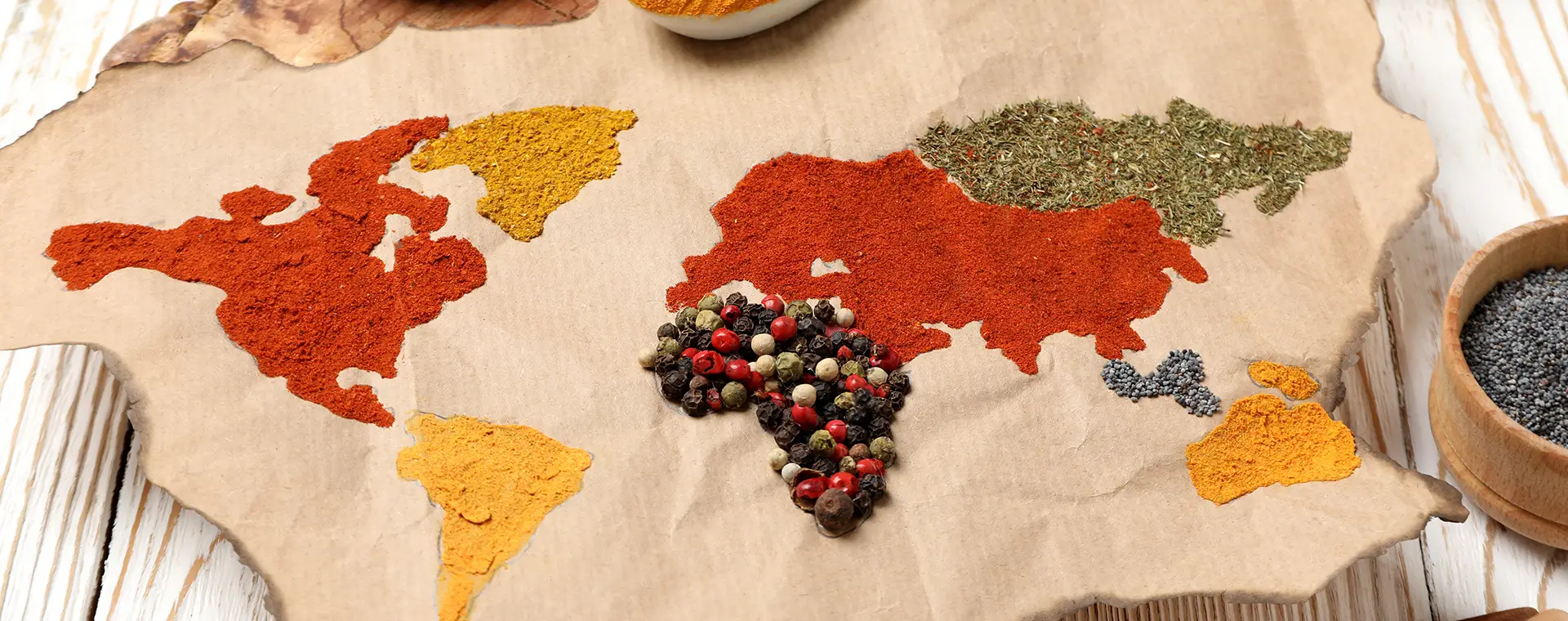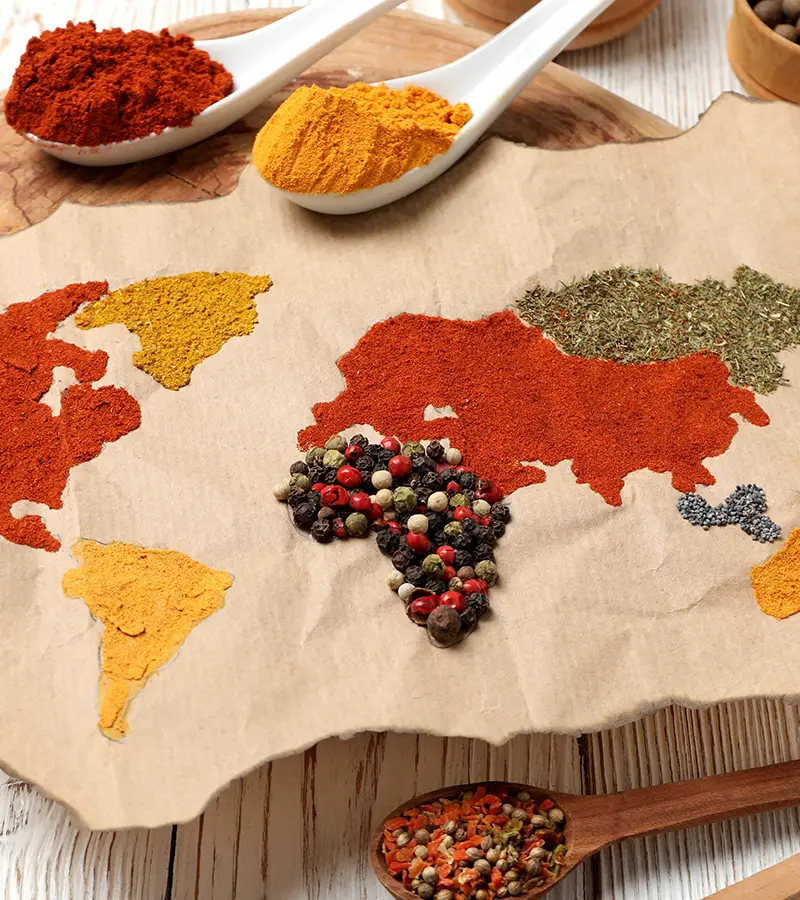

Global Food Trends: Are we headed towards a cultural amalgamation?
Embark on a culinary odyssey through global food trends, from plant-based revolutions to tech-driven dining.
From being a means of sustenance, food is now a global industry. We are surrounded by chefs, social media influencers, and culinary experts sharing, creating, or promoting the latest food trends. Social media platforms are constantly buzzing with posts that are a gateway to new tastes, sustainability, and tech-savvy dining experiences. From the plant-based dishes gracing celebrity tables to the ancient grains making a comeback in the chicest smoothie bowls, we are diving deep into the dynamic world of food trends shaping our plates and palates.
The Evolving Palette of the World
The world is becoming smaller. Home-style dishes from Japan are now served in a small eatery in Pune. Daulat ki chaat from the streets of Delhi is on the tasting menu of an award-winning restaurant. The world is becoming not only smaller but also more open when it comes to food. The culinary landscape is filled with a demand for regional flavors combined with sustainability and technological innovation. This isn’t only about food; it’s about culture, health, and how a simple hashtag can inspire a new way of eating. And the way we eat is changing who we are.
Our food decisions might seem personal, but they are part of the bigger collective. Each dish we select comes with wisdom, learnings, and implications impacting the world.
A shift towards sustainability with plant-based offerings and conscious consumerism
Plant-based diets are not new. Multiple civilizations, including ours, have a strong repertoire of pure vegetarian dishes that use zero animal products. But for the West, it’s a new concept that started as a fad but is now finding a solid place in the narrative around sustainability. Several celebrities and influencers are leading the charge. Posts around #MeatlessMondays, vegan burgers, and mock meats are slowly becoming the norm. As more people understand the benefits, the wave will only get stronger.
Adopting a plant-based diet also opens people up to other cuisines. From the use of coconut milk to eating more legumes and locally-grown vegetables. From eating rice noodles to good old roti, eating habits are changing. As the world moves away from the Westernized idea of “Steak & Wine” or animal protein dinners, we see a more global table.
Today’s diners are choosing with their values, opting for locally sourced, organic ingredients that taste better and do better for the planet. The farm-to-table movement is no longer a trend; it’s a lifestyle. This shift towards conscious consumerism is reflected in our dining choices, social media posts, and how we think about food, making sustainability the new norm.
Fermentation, embracing the funk
While most ancient civilizations have used fermentation in some form or another, the West is slowly waking up to its benefits. If we look at Indian foods, the most apparent dishes that use this technique are idli, dosas, vadas, dhoklas, and even the north-Indian staple of bhaturas. But we want to dive deeper to look at the health benefits. In that case, kanjis from the north and panta bhat from the east are our grandmothers’ secret weapons to fortify our immunity and gut health for generations. The smell might be off-putting, but the benefits are too many to avoid.
With a focus on building gut health with natural foods, a global wave has made these traditionally funky, smelly dishes mainstream. Fermented items like kimchi, kombucha, and kefir are no longer just food trends; they’re lifestyle choices that echo across our social media feeds, blending ancient wisdom with modern wellness.
Blending borders with global flavors and fusion cuisines
Fusion cuisine is no longer about filling a samosa with Hakka noodles or adding butter chicken gravy to a burger. Our culinary boundaries are expanding, creating new cuisines that fuse the best of different worlds. It’s like mixing your favorite songs into a new track, where the beats of Asian spices, African herbs, and Latin American zest create a universally delicious melody. You will now find hints of Peruvian cuisine mixed with Japanese cooking techniques or meals that have kept the lessons of Ayurveda in mind. This trend celebrates diversity, inviting us to explore the world one bite at a time.
Additionally, there has been a resurgence in including ancient grains like millet in daily meals. While locals used these for centuries, the acceptance and affection they are receiving is new. They are the superstars of the most vibrant, health-forward recipes online, offering a blend of taste and tradition that’s hard to beat. They’re not just good for you; they’re good for the planet.
Technological Transformation in the Food Industry
Tech is revolutionizing how we eat, from lab-grown meats to AI-powered nutrition apps. You can now connect with a personal dietitian on your phone or contact a virtual chef to help you choose, cook, and enjoy healthier and sustainable food. This trend is slowly making headlines, promising a future where eating right is accessible for everyone.
Technology and tradition are blending in exciting ways in the modern culinary world. From recipe-sharing apps to online cooking classes, the digital world enhances how we engage with traditional cooking practices. This fusion of the old and the new creates a culinary landscape that’s innovative, diverse, and deeply rooted in history, offering the best of both worlds to food enthusiasts everywhere.
Human connection through food
In a world craving connection, food has become a powerful social tool. From shared meals to food festivals, culinary experiences are about more than just eating; they bring people together. These moments, captured and shared online, highlight the power of food to bridge cultural divides and build communities, one delicious dish at a time.
Culinary tourism is also rising, with people traveling far and wide for the most authentic, local dining experiences. This trend is about exploring the world through its flavors, creating memories that are as tasty as they are memorable. It’s a way to connect with different cultures, one plate at a time, making every meal an adventure worth sharing.
The final word
In wrapping up this culinary odyssey, it’s clear that the global food trends of today reflect our evolving world. As we embrace diverse flavors, sustainable practices, and technological innovations, our food choices become a testament to our collective values and aspirations. Just like the engaging narratives explored by Vivek Ranjan Agnihotri, these trends showcase the interconnectedness of our global community, proving that food is indeed a narrative of our times, a dialogue between tradition and innovation, and a delicious journey towards a more conscious and connected world. Let’s keep exploring, sharing, and enjoying this culinary adventure, one trendsetting dish at a time.






